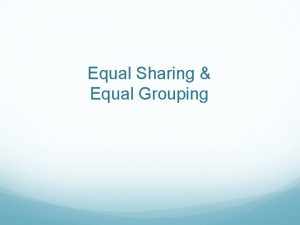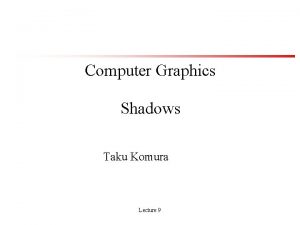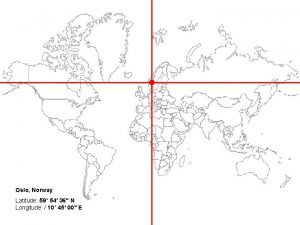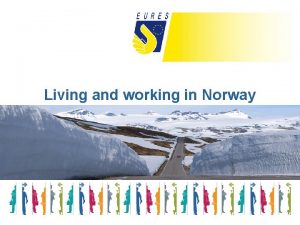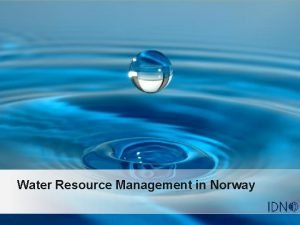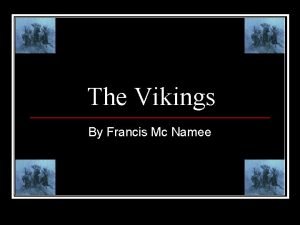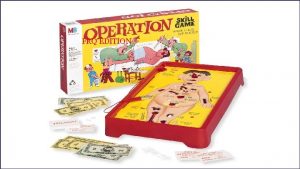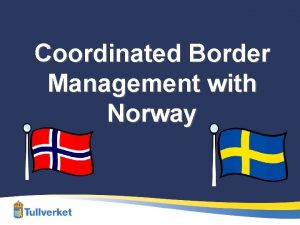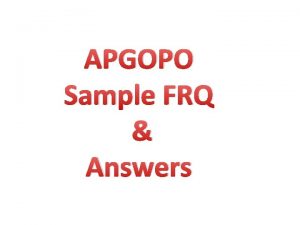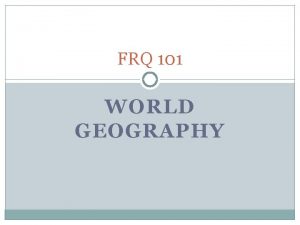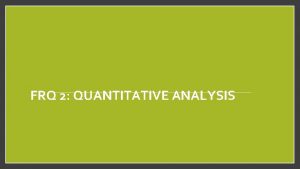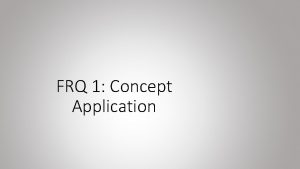PRACTICE FRQ Sweeden and Norway use equal quantites










- Slides: 10

PRACTICE FRQ

Sweeden and Norway use equal quantites of resources to produce food and capital goods. The table below shows the maximum possible production of food OR capital goods for each country. Country Food Capital Goods Sweden 50 100 Norway 30 120 (a) Draw a correctly labeled graph of the production possibilities curve for Sweden. Place food on the horizontal axis and capital goods on the vertical axis. Plot the relevant numberical values on the graph.

Sweeden and Norway use equal quantites of resources to produce food and capital goods. The table below shows the maximum possible production of food OR capital goods for each country. Country Food Capital Goods Sweden 50 100 Norway 30 120 (a) Draw a correctly labeled graph of the production possibilities curve for Sweden. Place food on the horizontal axis and capital goods on the vertical axis. Plot the relevant numberical values on the graph. Capital goods 100 50 food

Sweeden and Norway use equal quantites of resources to produce food and capital goods. The table below shows the maximum possible production of food OR capital goods for each country. Country Food Capital Goods Sweden 50 100 Norway 30 120 (b) On your graph in part (a), indicate the following. (i) a point that represents an efficient level of production, laveled E (ii) a point that represents an inefficient level of production, labeled I (iii) a point that represents an unattainable level of production, labeled U Capital goods 100 50 food

Sweeden and Norway use equal quantites of resources to produce food and capital goods. The table below shows the maximum possible production of food OR capital goods for each country. Country Food Capital Goods Sweden 50 100 Norway 30 120 (b) On your graph in part (a), indicate the following. (i) a point that represents an efficient level of production, laveled E (ii) a point that represents an inefficient level of production, labeled I (iii) a point that represents an unattainable level of production, labeled U Capital goods 100 E U I 50 food

Sweeden and Norway use equal quantites of resources to produce food and capital goods. The table below shows the maximum possible production of food OR capital goods for each country. Country Food Capital Goods Sweden 50 100 Norway 30 120 (c) Assume Sweden moves from producing 20 units of food and 60 units of capital goods to producing 30 units of food and 40 units of capital goods. What will happen to economic growth in Sweden in the future? Economic growth will decrease. When fewer capital goods are produced equipment is not updated and it slows economic growth

Sweeden and Norway use equal quantites of resources to produce food and capital goods. The table below shows the maximum possible production of food OR capital goods for each country. Country Food Capital Goods Sweden 50 100 Norway 30 120 (d) Which country has the comparative advantage in the production of capital goods? Explain. Food Sweeden Norway Capital Goods

Sweeden and Norway use equal quantites of resources to produce food and capital goods. The table below shows the maximum possible production of food OR capital goods for each country. Country Food Capital Goods Sweden 50 100 Norway 30 120 (d) Which country has the comparative advantage in the production of capital goods? Explain. Food Capital Goods Sweeden 50 – 1 food = 100/50 1 food = 2 capital goods 100 – 1 capital good = 50/100 1 capital good = ½ food Norway 30 – 1 food = 120/30 1 food = 4 capital goods 120 – 1 capital good = 30/120 1 capital good = ¼ food

Sweeden and Norway use equal quantites of resources to produce food and capital goods. The table below shows the maximum possible production of food OR capital goods for each country. Country Food Capital Goods Sweden 50 100 Norway 30 120 (d) Which country has the comparative advantage in the production of capital goods? Explain. Food Capital Goods Sweeden 50 – 1 food = 100/50 1 food = 2 capital goods 100 – 1 capital good = 50/100 1 capital good = ½ food Norway 30 – 1 food = 120/30 1 food = 4 capital goods 120 – 1 capital good = 30/120 1 capital good = ¼ food Norway has the comparative advantage in capital goods. Norway’s opportunity cost to produce food is lower than Sweeden’s

Sweeden and Norway use equal quantites of resources to produce food and capital goods. The table below shows the maximum possible production of food OR capital goods for each country. Country Food Capital Goods Sweden 50 100 Norway 30 120 (e) Based on the table above, identify a specific number of units of capital goods that could be traded for 10 units of food and be mutually beneficial Food Capital Goods Sweeden 50 – 1 food = 100/50 1 food = 2 capital goods 100 – 1 capital good = 50/100 1 capital good = ½ food Norway 30 – 1 food = 120/30 1 food = 4 capital goods 120 – 1 capital good = 30/120 1 capital good = ¼ food Sweeden will trade 1 food and must get at least 2 capital goods SO 10 food they must get at least 20 capital goods

